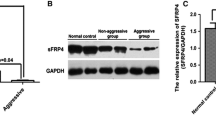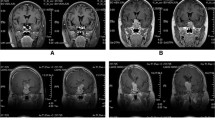Summary
The Leucine-rich repeats and immunoglobulin-like domains-2 (LRIG2) gene expression in pituitary adenoma and its correlation with tumor invasiveness were studied. The expression of LRIG2 mRNA and protein in human pituitary adenoma obtained surgically was detected by RT-PCR (39 cases) and immunohistochemical staining (30 cases). It was found that LRIG2 was mostly localized at the nucleus of the pituitary adenoma cells. Its expression was significantly higher in the invasive cases than in the non-invasive cases. LRIG2 protein was positive in 14 cases out of 21 cases of invasive adenoma, but only 2 cases were positive in 9 cases of non-invasive adenoma. The positive expression rate of LRIG2 mRNA was 91.3% in invasive cases (total 23 cases) and 62.5% in non-invasive cases (total 16 cases), respectively. LRIG2 gene is overexpressed in invasive pituitary adenoma. It may play an important role in pituitary adenoma invasiveness and further studies are necessary to elucidate the mechanism under this phenomenon.
Similar content being viewed by others
References
Hashimoto N, Handa H, Yamashita J, et al. Long-term follow-up of large or invasive pituitary adenoma. Surg Neurol, 1986,25(1):49–54
Goel A, Nadkarni T, Muzumdar D, et al. Giant pituitary tumors: a study based on surgical treatment of 118 cases. Surg Neurol, 2004,61(5):436–445
Nilsson J, Vallbo C, Guo D, et al. Cloning, characterization, and expression of human LIG1. Biochem Biophys Res Commun, 2001,284(5):1155–1161
Guo D, Holmlund C, Henriksson R, et al. The LRIG gene family has three vertebrate paralogs widely expressed in human and mouse tissues and a homolog in Ascidiacea. Genomics, 2004,84(1):157–165
Hedman H, Nilsson J, Guo D, et al. Is LRIG1 a tumor suppressor gene at chromosome 3p14.3? Acta Oncol, 2002,41(4):352–354
Yang WM, Yan ZJ, Ye ZQ, et al. LRIG1, a candidate tumor-suppressor gene in human bladder cancer cell line BIU87. BJU Int, 2006,98(4):898–902
Hedman H, Henriksson R. LRIG inhibitors of growth factor signalling — double-edged swords in human cancer? Eur J Cancer, 2007,43(4):676–682
Wang B, Han L, Chen R, et al. Downregulation of LRIG2 expression by RNA interference inhibits glioblastoma cell (GL15) growth, causes cell cycle redistribution, increases cell apoptosis and enhances cell adhesion and invasion in vitro. Cancer Biol Ther, 2009,8(11):1018–1023
Cai M, Han L, Chen R, et al. Inhibition of LRIG3 gene expression via RNA interference modulates the proliferation, cell cycle, cell apoptosis, adhesion and invasion of glioblastoma cell (GL15). Cancer Lett, 2009,278(1): 104–112
Guo D, Han L, Shu K, et al. Down-regulation of leucine-rich repeats and immunoglobulin-like domain proteins (LRIG1-3) in HP75 pituitary adenoma cell line. J Huazhong Univ Sci Technolog Med Sci, 2007,27(1): 91–94
Scheithauer BW, Kovacs KT, Laws ER Jr, et al. Pathology of invasive pituitary tumors with special reference to functional classification. J Neurosurg, 1986,65(6):733–744
Oruckaptan HH, Senmevsim O, Ozcan OE, et al. Pituitary adenomas: results of 684 surgically treated patients and review of the literature. Surg Neurol, 2000,53(3): 211–219
Onguru O, Scheithauer BW, Kovacs K, et al. Analysis of epidermal growth factor receptor and activated epidermal growth factor receptor expression in pituitary adenomas and carcinomas. Mod Pathol, 2004, 17:772–780
Theodoropoulou M, Arzberger T, Gruebler Y, et al. Expression of epidermal growth factor receptor in neoplastic pituitary cells: evidence for a role in corticotropinoma cells. J Endocrinol, 2004,183(2):385–394
Chaidarun SS, Eggo MC, Sheppard MC, et al. Expression of epidermal growth factor (EGF), its receptor, and related oncoprotein (erbB-2) in human pituitary tumors and response to EGF in vitro. Endocrinology, 1994,135(5): 2012–2021
Musacchio M, Perrimon N. The Drosophila kekkon genes: novel members of both the leucine-rich repeat and immunoglobulin superfamilies expressed in the CNS. Dev Biol, 1996,178(1):63–76
Ghiglione C, Carraway KL 3rd, Amundadottir LT, et al. The transmembrane molecule kekkon 1 acts in a feedback loop to negatively regulate the activity of the Drosophila EGF receptor during oogenesis. Cell, 1999,96(6):847–856
Guo D, Nilsson J, Haapasalo H, et al. Perinuclear leucine-rich repeats and immunoglobulin-like domain proteins (LRIG1-3) as prognostic indicators in astrocytic tumors. Acta Neuropathol, 2006, 111(3):238–246
Laederich MB, Funes-Duran M, Yen L, et al. The leucinerich repeat protein LRIG1 is a negative regulator of ErbB family receptor tyrosine kinases. J Biol Chem, 2004, 279(45):47050–47056
Shattuck DL, Miller JK, Laederich M, et al. LRIG1 is a novel negative regulator of the Met receptor and opposes Met and Her2 synergy. Mol Cell Biol, 2007,27(5): 1934–1946.
Ledda F, Bieraugel O, Fard SS, et al. Lrig1 is an endogenous inhibitor of Ret receptor tyrosine kinase activation, downstream signaling, and biological responses to GDNF. J Neurosci, 2008,28(1):39–49
Hedman H, Lindström AK, Tot T, et al. LRIG2 in contrast to LRIG1 predicts poor survival in early-stage squamous cell carcinoma of the uterine cervix. Acta Oncol, 2010,49(6):812–815
Holmlund C, Nilsson J, Guo D. Characterization and tissue-specific expression of human LRIG2. Gene, 2004, 33(2):35–43
Holmlund C, Haapasalo H, Yi W, et al. Cytoplasmic LRIG2 expression is associated with poor oligodendrog lioma patient survival. Neuropathology, 2009,29(3):242–247
Eisenstat DD, Gibson SB. RIGging functional outcomes in glioma cells: new insights into LRIG proteins in malignant gliomas. Cancer Biol Ther, 2009,8(11):1024–1026
Author information
Authors and Affiliations
Corresponding author
Rights and permissions
About this article
Cite this article
Zhang, H., Yan, Q., Xu, S. et al. Association of expression of Leucine-rich repeats and immunoglobulin-like domains 2 gene with invasiveness of pituitary adenoma. J. Huazhong Univ. Sci. Technol. [Med. Sci.] 31, 520–523 (2011). https://doi.org/10.1007/s11596-011-0483-3
Received:
Published:
Issue Date:
DOI: https://doi.org/10.1007/s11596-011-0483-3




